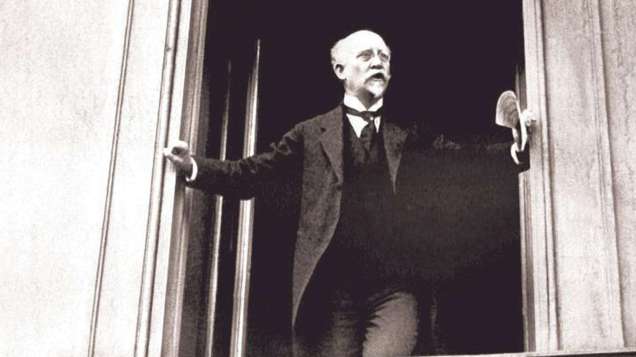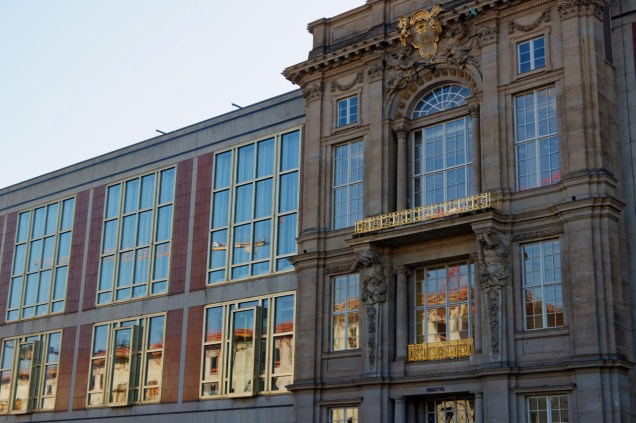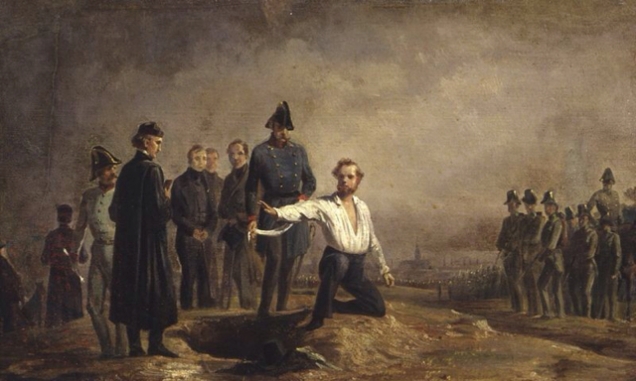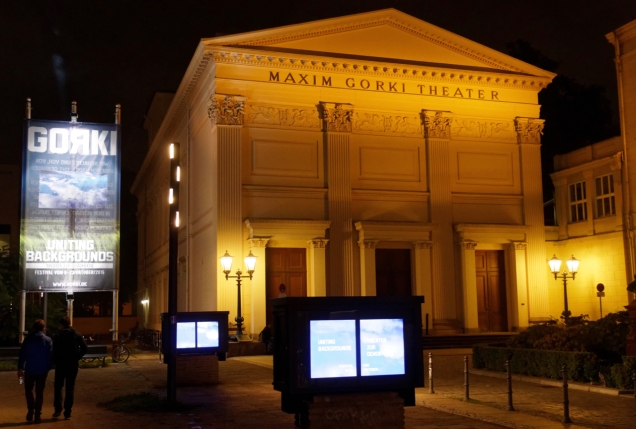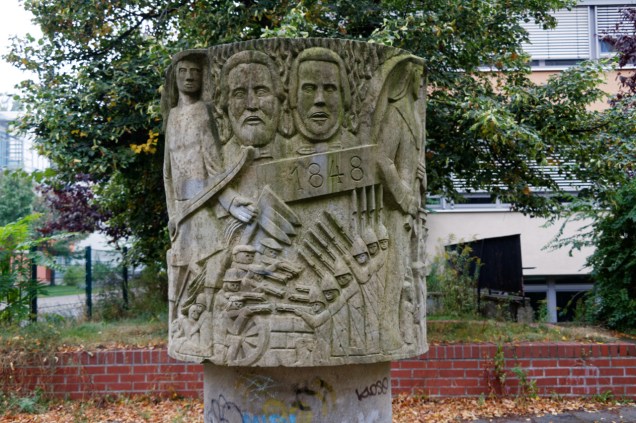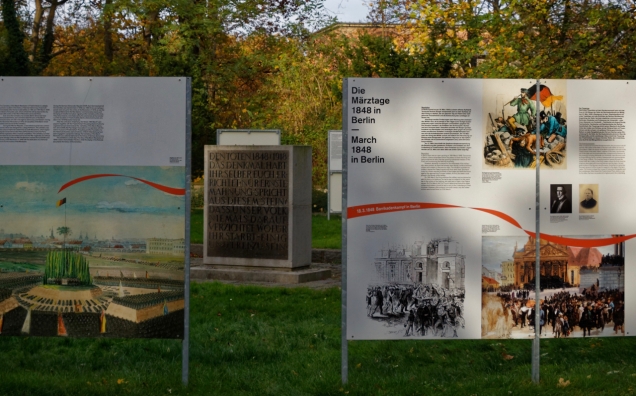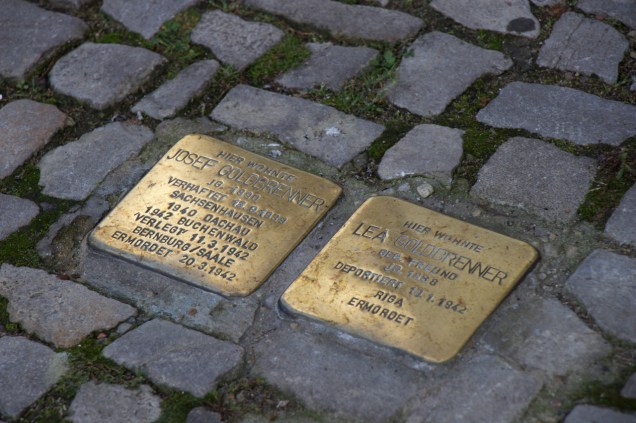
Heute ist 9. November – ein Tag der in Berlin vor Allem mit dem Mauerfall verbunden ist. Und das ist gut so – auch wenn es an diesem deutschen Schicksalstag noch vieles anderes zu gedenken gibt. Neben der Hinrichtung Robert Blums am 9.11.1848, der Abdankung des Kaisers am 9.11.1918 und dem Hitlerputsch am 9.11.1923, ist das vor Allem die Reichspogromnacht am 9.11.1938. In dieser Nacht (und an der Nacht des 10.11) überfielen die Nazihorden und ihre Mitläufer Jüdische Geschäfte, Synagogen und andere Eigentümer. Die Aktionen trieben etwa 400 Juden in den Tod; viele mehr wurden verhaftet und in Konzentrationslager überführt.
Zum Gedenken der Reichspogromnacht 1938 finden an vielen deutschen Orten von Freiwilligen veranstaltete Putzaktionen für Stolpersteine statt – jene kleine im Bürgersteig eingelassenen Gedenktafeln aus Messing, die seit 1992 vom Künstler Gunter Demnig überall in Europa vor den letzten frei gewählten Wohnungen ermordeter Juden angebracht werden.
 Das Haus Invalidenstrasse 2, Berlin-Mitte. Vor der Haustür befinden sich die zwei Josef und Lea Goldbrenner gedenkenden Stolpersteine. Foto: Robin Oomkes
Das Haus Invalidenstrasse 2, Berlin-Mitte. Vor der Haustür befinden sich die zwei Josef und Lea Goldbrenner gedenkenden Stolpersteine. Foto: Robin OomkesVor unserem Wohnhaus in Berlin-Mitte befinden sich zwei Stolpersteine, für Josef und Lea Goldbrenner. Die Steine gab es schon als wir Anfang 2014 einzogen, und uns war von der Familie Goldbrenner nicht mehr bekannt, als was wir auf die Steine lesen konnten: Josef wurde 1890 geboren, 1939 verhaftet und nach dem KZ Sachsenhausen gebracht, und wurde dann 1942 nach verschiedenen Verlegungen (über Dachau und Buchenwald) in der Tötungsanstalt in Bernburg/Saale ermordet. Lea Goldbrenner wurde 1888 geboren und 1942 nach Riga deportiert, wo sie ermordet wurde.

Aber im Juni 2016 erfuhren wir mehr: vor unserer Haustür traf ich zwei knieende Personen, die die Stolpersteine putzten. Es waren Günter Wongel (geb. 1941) und seine Frau Gisela. Sie waren, zusammen mit den Enkelkindern der Familie Goldbrenner 2013 für die Initiative zuständig, Stolpersteine für Josef und Lea Goldbrenner anbringen zu lassen. Günter Wongel ist im Haus Invalidenstr. 2 aufgewachsen; er wohnte mit seinen Eltern in der Wohnung am 5. Stock. (Durch Kriegsschäden gibt es diese Wohnung nicht mehr; das Haus ist heute oben des 4. Stockwerks mit einem flachen Satteldach ausgestattet.)
Günter war zu jung um die Deportation 1942 Lea Goldbrenners bewusst zu erfahren, und zur Zeit der Verhaftung Josef Goldbrenners 1939 war er noch nicht geboren. Trotzdem hat seine Mutter Emilie, die im Haus die Hauswartsstelle inne hatte, ihm viel über die Familie Goldbrenner, die im 1. Stock wohnten, erzählt – wie Lea geweint hat, als Josef von der Gestapo weggeführt wurde, und wie sie damals für die Goldbrenners am Sabbat Feuer gemacht hat. Als es Juden schon nicht mehr erlaubt war, einkaufen zu gehen, hielf Emilie Wongel die Nachbarin indem sie für sie einkaufen ging. Emilie Wongel wurde beschimpft dass sie ‘wohl wieder für die Juden einkäufe’, weil die von ihr gekauften Waren, zum Beispiel frische Gurken, für die Familie Wongel wohl zu teuer waren.

In den siebziger Jahren haben Günter und Gisela Wongel selber noch einige Zeit in der Invalidenstrasse 2 gewohnt, und immer wieder an den weggeführten Nachbarn gedacht. Seitdem sind die beiden nach Pankow umgezogen, aber ein Kunstwerk von der Hand von Günter, gelerntem Grafiker, erinnert noch an die Zeit in der Invalidenstrasse.
Mindestens einer der Kinder der Familie Goldbrenner, Willy, hat den Krieg und die Konzentrationslager überlebt. Willy emigrierte nach Frankreich. Er und seine Frau Estera bekamen 1943 einen Sohn, Jean-Claude. Estera wurde kurz nachdem verhaftet und in Auschwitz ermordet. Jean-Claude Goldbrenner überlebte den Krieg geschützt von seinen französischen Grosseltern und lebt heute in den USA. Über seine Lebensgeschichte erfährt man mehr unter http://www.deseretnews.com/article/700168866/Holocaust-survivor-treasures-mothers-last-letters.html?pg=all.
Günter und Gisela Wongel haben ihre Erinnerungen an und Spurensuche nach Josef und Lea Goldbrenner in zwei Dokumente erfasst, die ich gerne empfehle:
Heute Abend werden meine Frau und ich für Josef und Lea Goldbrenner bei den Stolpersteinen eine Kerze brennen.


